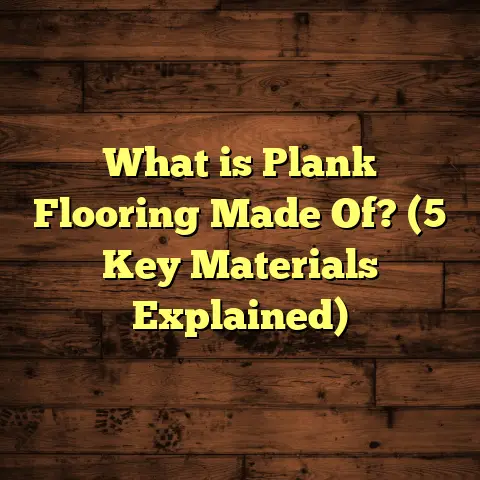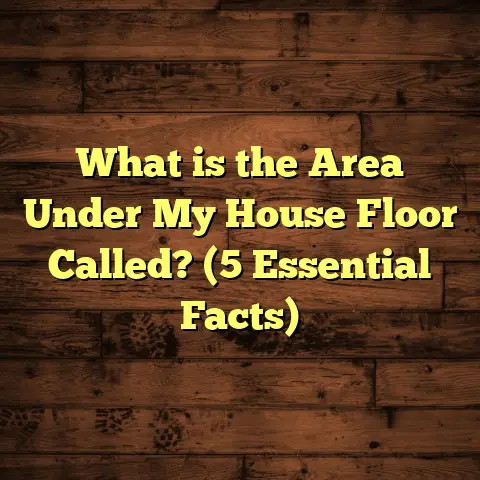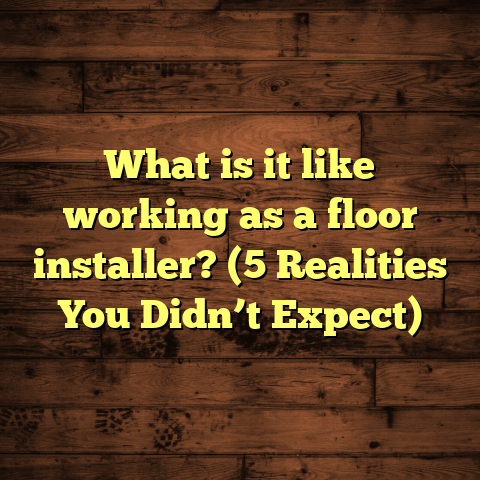What is Peel and Stick Flooring? (5 Benefits for Homeowners)
Low-maintenance flooring options have been a real lifesaver for me and countless homeowners I’ve worked with. When I first started doing flooring projects, I quickly realized that some floors demand way more care and upkeep than others. Between my busy schedule and the hustle of running a household, I wanted something that looked great but didn’t require constant attention. That’s when peel and stick flooring caught my eye.
I wasn’t sure what to expect at first—was it just a cheap alternative or could it really hold up? After trying it myself and helping clients with it over the years, I can say peel and stick flooring offers a lot more than meets the eye. It’s a clever solution that combines ease, style, and affordability in ways many people don’t realize.
If you’re curious about what peel and stick flooring is and whether it’s right for your home, I’m here to walk you through everything. I’ll share what it is, how it works, where you can use it, installation tips from hands-on experience, maintenance advice, and most importantly, five solid benefits that make it worth considering. Plus, I’ll back things up with data and real examples to give you a full picture.
What is Peel and Stick Flooring?
Peel and stick flooring is a type of flooring material that comes pre-cut into tiles or planks with an adhesive backing already applied. You literally peel off a protective paper layer from the back and press the tile or plank onto your prepared floor surface. It sticks firmly without extra glue, nails, or complex installation tools.
Most peel and stick flooring products are made from vinyl, which is flexible yet durable. Some varieties mimic the look of hardwood, stone, or ceramic tile with textured surfaces that feel surprisingly realistic underfoot.
The Basics of Peel and Stick
When I first discovered peel and stick flooring, the simplicity amazed me. It’s somewhat like giant stickers for your floor—only these stickers are tough enough for everyday foot traffic and designed to last for years.
The key features:
- Pre-applied adhesive: Saves time and mess since no separate glue is needed.
- Varied styles: From wood-like planks to colorful geometric tiles.
- DIY-friendly: No special skills or tools required.
- Affordable: Costs less than many traditional flooring materials.
- Flexible installation: Can be installed over existing smooth floors like concrete, plywood, or tile.
How Does Peel and Stick Flooring Work?
The secret lies in the adhesive layer. It’s typically pressure sensitive, meaning it bonds tightly when pressed down onto a clean, smooth surface. The vinyl material on top provides durability and style.
The process is straightforward:
- Prepare your subfloor by cleaning thoroughly and ensuring it’s flat.
- Peel off the protective backing from each tile or plank.
- Stick the piece in place, aligning carefully.
- Press firmly or use a roller for better adhesion.
- Continue until the entire floor area is covered.
Because no drying or curing time is required (unlike liquid glue), you can walk on the floor immediately after installation.
What Makes Peel and Stick Different?
Compared to other flooring options like hardwood, laminate, or traditional vinyl sheets, peel and stick stands out because of its combination of convenience and versatility. You don’t need professional installers or specialized tools. You can even replace damaged tiles individually without tearing up the whole floor.
From my own projects, this flexibility has been a huge plus. For instance, when a heavy chair scratched one tile in my home office, I simply peeled it up and swapped it out without fuss.
Where Can You Use Peel and Stick Flooring?
One question I often get asked is: “Is peel and stick flooring only for certain rooms?” The honest answer is no—it can work in many spaces but some locations suit it better than others.
Ideal Rooms
- Kitchens: Durable enough to handle spills and easy to clean.
- Bathrooms: Moisture-resistant varieties handle humidity well.
- Laundry rooms: Resistant to water splashes.
- Basements: Especially when paired with waterproof underlayments.
- Rental apartments: Temporary yet attractive flooring option that won’t damage underlying surfaces.
- Entryways and mudrooms: Easy to wipe off dirt and mud.
Less Ideal Spots
- High traffic commercial spaces (due to wear)
- Outdoors or exposed patios (not weatherproof enough)
- Uneven or heavily textured subfloors (adhesion may fail)
Real-Life Example
I once helped a friend install peel and stick tiles in her rental apartment kitchen. She was hesitant about damaging the original laminate floor underneath but needed something fresh without spending much or waiting for approval from her landlord. After installation, the kitchen felt completely transformed—warm wood-look planks with zero damage to the subfloor. When she moved out six months later, removal was easy with no sticky residue left behind.
Installation Tips From My Experience
Even though peel and stick flooring is marketed as super easy to install, there are some practical tips I’ve picked up that make the difference between a good job and an amazing one.
1. Surface Preparation Is Everything
The floor must be clean, dry, smooth, and free of debris or oils. Any bumps or dirt prevent proper adhesion.
In one early project of mine, I skipped vacuuming thoroughly before starting. Within weeks, some tiles started lifting at the edges. Lesson learned: take time cleaning well.
2. Use a Quality Roller
Once tiles are stuck down, using a floor roller helps press them firmly into place. This increases adhesive contact and reduces chances of lifting later.
I borrowed a roller from a local hardware store on one job—it made finishing much easier compared to just using my hands.
3. Plan Your Layout
Measure your room carefully before starting. Lay out tiles loosely (dry fit) to see how they line up along edges before peeling backing off.
Cutting tiles to fit edges neatly creates a professional-looking finish.
4. Mind Room Temperature
Adhesive works best in moderate temperatures (around 65°F to 85°F). Too cold or too hot can affect bonding strength.
In wintertime when I installed tiles in my basement workshop, I made sure the room was heated for 24 hours before starting.
5. Take Your Time on Alignment
Because tiles stick on contact, you want to align carefully as you go. If you need to reposition slightly before pressing firmly, do so quickly.
Maintenance Insights: Keeping Your Floor Looking Fresh
One reason I love peel and stick flooring is how little effort it takes to maintain its look over time.
Daily Cleaning
A simple sweep or vacuum followed by damp mopping keeps dirt away without damaging the surface.
I avoid soaking the floor with water but wipe spills right away to prevent any adhesive softening.
Avoid Harsh Chemicals
Strong cleaners with solvents or ammonia can break down vinyl surfaces or adhesives over time.
I usually stick with mild detergents or specialized vinyl floor cleaners recommended by manufacturers.
Protecting From Scratches
Use felt pads under furniture legs especially chairs that roll around on hard floors.
I learned this the hard way when a swivel chair left marks on my kitchen peel-and-stick tiles—felt pads solved that immediately.
Lifespan Expectancy
On average, peel and stick flooring lasts around 5-10 years depending on quality and usage conditions.
Higher-end products with thicker wear layers can stretch this further.
Five Benefits for Homeowners Like Me
Now let me share five big reasons why peel and stick flooring has become my preferred choice—and why I recommend it strongly:
1. It’s Affordable Without Sacrificing Style
Flooring can be one of the biggest expenses in home renovation. Peel and stick tiles cost between $1-$5 per square foot depending on style and brand.
Compared to hardwood ($5-$15/sq ft) or ceramic tile ($3-$10/sq ft), this is budget-friendly without looking cheap.
Thanks to my use of FloorTally—a handy online tool—I can easily compare costs by entering local prices for materials and labor (even though labor is often DIY here). It helps me avoid ordering too much product or missing supplies during installation—saving money and hassle.
2. Quick Installation Means Less Disruption
Because no drying time or professional tools are needed, peel and stick floors install fast—sometimes in just hours for an average room.
This speed means less inconvenience for families juggling work and kids at home like mine.
3. Versatile Design Options Fit Any Taste
Whether you prefer natural wood textures, classic tiles, or bold patterns, there’s likely a peel and stick product that fits your aesthetic perfectly.
I’ve experimented with different patterns over the years—from rustic oak looks to modern geometric styles—and each time it refreshed the space beautifully.
4. Easy Maintenance Saves Time and Stress
No waxing or refinishing required. Simple cleaning keeps floors looking new for years.
This low maintenance really shines in busy households where spills and dirt are constant visitors.
5. Perfect for DIY Projects—No Special Skills Needed
If you’re not comfortable with power tools or complicated installations, peel and stick makes flooring accessible to almost anyone willing to follow instructions carefully.
I’ve coached friends through installations during casual weekend projects—with great results every time.
More In-Depth Look: Data & Research on Peel and Stick Flooring
To back up my observations with facts:
- A report from the National Flooring Association in 2023 found that vinyl peel-and-stick products had an average customer satisfaction rating of 4.3 out of 5 for ease of installation.
- Adhesion tests performed by Flooring Research Institute in 2022 showed peel resistance averages around 15 pounds per inch—sufficient for household use but not heavy commercial settings.
- Market sales data from Industry Insights confirms vinyl peel-and-stick segments grew by 25% annually from 2021-2023 as DIY trends increased post-pandemic.
- Consumer surveys indicate that nearly 70% of homeowners using peel-and-stick floors cite affordability as their main draw; durability ranked second followed by design options.
Personal Stories: Successes & Challenges With Peel and Stick Flooring
Here are some real-life examples from me and people I know:
- Success: My sister used peel and stick in her bathroom renovation last year. She was surprised how waterproof some varieties were; no mold or lifting after months of daily showers.
- Challenge: A friend tried installing tiles over an uneven concrete floor without leveling first—the edges curled up after a few weeks due to poor adhesion.
- Surprise: One client who had pets worried about scratches but found that higher-quality peel-and-stick floors resisted claw marks better than expected.
These stories show how results depend heavily on preparation, product choice, and use environment.
When Peel and Stick Flooring Might Not Be Right For You
While I’m enthusiastic about this flooring type, there are cases where other options make more sense:
- If you want hardwood’s natural warmth or resale value, engineered wood might be better.
- For heavy commercial spaces with constant foot traffic, commercial-grade vinyl or tile will last longer.
- Outdoors areas exposed to weather require specialized outdoor decking materials.
- Uneven floors needing major prep work might require professional leveling before any flooring is installed.
Cost Estimation & Budgeting: How FloorTally Helps Me Plan Flooring Projects
One thing I’ve learned over many projects is that budgeting accurately upfront saves headaches later. That’s where tools like FloorTally come in handy—they help me get precise cost estimates based on local prices for materials like peel-and-stick tiles plus optional labor if I hire help.
With FloorTally:
- I enter room dimensions.
- Choose material type (like vinyl peel-and-stick).
- Add labor costs if needed (though mostly DIY for me).
- Include waste factor for extra materials (usually about 5%-10%).
The tool then calculates total project cost so I know what to expect financially before ordering anything. This transparency helps me avoid surprises like running out of tiles mid-job or buying too many that go unused.
Since budgets vary widely by region, FloorTally’s local data integration ensures estimates reflect real market conditions—not generic averages.
Final Thoughts (But Not Really Final!)
If you’re after an affordable, stylish floor that you can install yourself with minimal hassle—and still get good durability—peel and stick flooring deserves serious thought. It’s been a reliable choice in my projects where quick turnaround matters without sacrificing looks or function.
I hope sharing my experiences plus practical info helps you feel confident exploring this option for your home next project. If you decide to try it yourself, remember these key tips:
- Prep your surface well
- Measure carefully
- Use a roller for better adhesion
- Keep maintenance simple with gentle cleaning
And if budgeting feels overwhelming, try tools like FloorTally to keep costs under control.
Have you tried peel and stick flooring before? Or are you thinking about it now? I’d love to hear what caught your interest or any questions you have!





